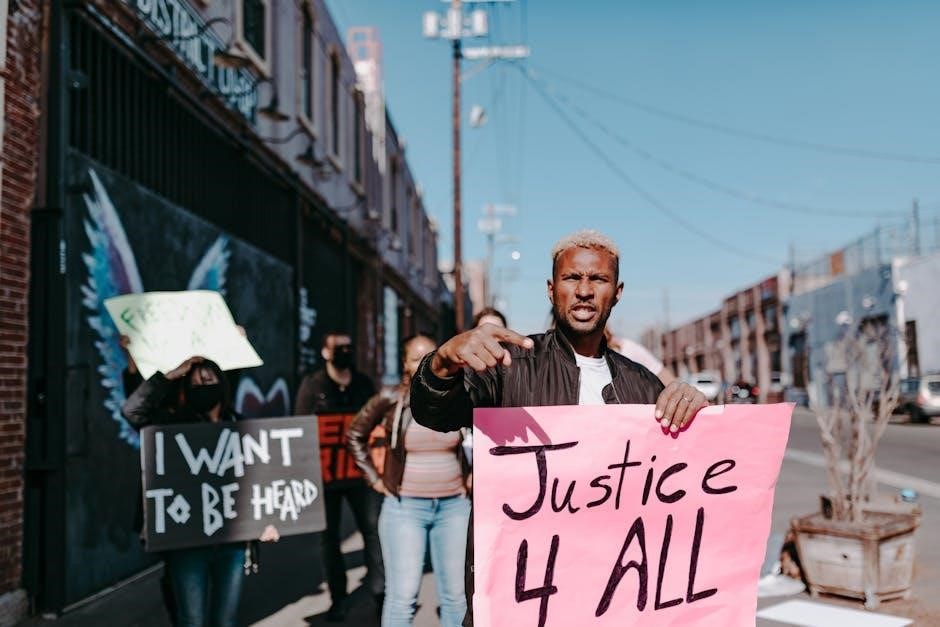This section introduces the foundational concepts of policing within societal contexts, exploring the evolution of law enforcement, community relationships, and modern challenges in maintaining public order and safety.
1.1 Overview of the Book
The eighth edition of Police and Society provides a comprehensive analysis of policing practices, historical development, and contemporary challenges. It explores the relationship between law enforcement and the community, emphasizing ethical considerations, legal frameworks, and technological advancements. The book covers key themes such as community-oriented policing, accountability mechanisms, and emerging issues like cybercrime and terrorism. With updated insights and fresh perspectives, it offers a detailed understanding of modern policing, making it an essential resource for students, scholars, and professionals in the field of law enforcement and criminal justice.
1.2 Importance of Studying Police and Society
Studying police and society is crucial for understanding the complex dynamics between law enforcement and the communities they serve. It provides insights into the historical evolution of policing, ethical dilemmas, and contemporary challenges such as racial bias and technological advancements. By examining these aspects, individuals can gain a deeper appreciation of the role police play in maintaining social order and justice. This knowledge is essential for fostering public trust, improving police practices, and addressing systemic issues that impact society as a whole.
1.3 Key Themes in the 8th Edition
The 8th edition of Police and Society explores critical themes such as police accountability, community relationships, and technological advancements in law enforcement. It delves into ethical challenges, including racial bias and discrimination, while emphasizing the importance of transparency and trust-building. The text also addresses emerging issues like cybercrime, terrorism, and globalization, providing a comprehensive analysis of modern policing. By examining these themes, the edition offers valuable insights into the complexities of law enforcement and its role in maintaining justice and order in contemporary society.

Historical Development of Policing
This section traces the origins of law enforcement, from early forms of communal regulation to the establishment of modern police forces, highlighting key milestones and principles.
2.1 Early Forms of Law Enforcement
Early law enforcement emerged from communal needs for order and safety. Ancient societies relied on informal systems, such as watch groups and tribal leaders. Medieval Europe saw the rise of constables and night watches. The 19th century brought professional policing, influenced by the Peelian Principles, emphasizing crime prevention and community trust. These early systems laid the groundwork for modern policing, focusing on maintaining social order and protecting citizens. The evolution reflects societal changes and the growing need for structured law enforcement. This section highlights how historical developments shaped contemporary policing practices and philosophies.
2.2 Evolution of Modern Policing
Modern policing evolved from informal community watch systems to formalized forces. The 19th century saw the establishment of professional police departments, influenced by the Peelian Principles. Urbanization and industrialization drove the need for structured law enforcement. Professionalization included standardized training and centralized command structures. Technological advancements, like communication systems, enhanced operational efficiency. Contemporary policing emphasizes community-oriented strategies and problem-solving approaches, reflecting societal demands for accountability and transparency. This evolution highlights the adaptability of law enforcement to meet changing societal needs while maintaining core principles of public safety and trust.
2.3 The Peelian Principles and Their Impact
The Peelian Principles, formulated by Sir Robert Peel, laid the groundwork for modern policing. Emphasizing crime prevention, public consent, and minimal force, these principles revolutionized law enforcement. They established policing as a public service, prioritizing community trust and accountability. The principles advocate for impartial law enforcement and proportional responses to situations. Their impact is evident in contemporary policing strategies, where building public confidence and collaboration remains central. These foundational ideas continue to guide police reforms and ethical practices, ensuring that policing aligns with societal values and expectations for fairness and transparency.

Legal Framework of Policing
This section examines the constitutional rights, legal powers, and accountability mechanisms that govern policing, ensuring officers operate within the bounds of the law while protecting societal interests.
3.1 Constitutional Rights and Police Powers
The legal framework of policing is rooted in constitutional rights, which balance individual freedoms with police authority. Police powers are derived from legal statutes, ensuring officers act lawfully while enforcing the law. Constitutional amendments, such as the Fourth and Fourteenth, govern search, seizure, and due process, limiting police overreach. Case law further refines these boundaries, emphasizing accountability and transparency. Understanding these principles is crucial for ethical policing, as they protect citizens while empowering law enforcement to maintain order and justice in society.
3.2 Legal Issues in Contemporary Policing
Contemporary policing faces complex legal challenges, including use of force, privacy rights, and racial bias. Technological advancements, like surveillance and data collection, raise concerns about civil liberties. High-profile cases often highlight disparities in justice, prompting calls for reform. Legal frameworks must adapt to address these issues while ensuring public safety. Police accountability mechanisms, such as body cameras and civilian oversight, aim to balance authority with transparency. These challenges underscore the need for ongoing legal education and policy updates to maintain trust and fairness in law enforcement practices.
3.3 Accountability Mechanisms in Policing
Accountability mechanisms ensure police actions align with legal and ethical standards, fostering trust and transparency. Internal affairs units investigate misconduct, while civilian review boards provide independent oversight. Judicial oversight and public scrutiny further enhance accountability. Technological tools, like body cameras, offer evidence-based oversight. These mechanisms are crucial for addressing misconduct, improving transparency, and rebuilding public confidence. They ensure that police actions are fair, lawful, and subject to review, maintaining the integrity of law enforcement and its relationship with society. Effective accountability is essential for modern policing to function ethically and responsibly.

Police Strategies and Tactics
Modern policing employs strategies like community-oriented, problem-oriented, and technological approaches to enhance effectiveness and build trust. These tactics focus on proactive crime prevention and collaborative efforts.
- Community-oriented policing fosters partnerships with citizens.
- Problem-oriented policing addresses root causes of crime.
- Technological advancements improve efficiency and transparency.
4.1 Community-Oriented Policing
Community-oriented policing emphasizes collaboration between law enforcement and the public to identify and address crime issues. It focuses on building trust, fostering partnerships, and empowering communities to take an active role in crime prevention. By engaging in open dialogue and understanding local needs, police can tailor strategies to specific neighborhoods, enhancing safety and satisfaction. This approach prioritizes problem-solving and long-term solutions over reactive measures, fostering a sense of shared responsibility. Effective COP requires cultural sensitivity, transparency, and continuous communication, ultimately leading to stronger, more resilient communities and reduced crime rates through proactive engagement and mutual respect.
4.2 Problem-Oriented Policing
Problem-oriented policing focuses on identifying and addressing the underlying causes of crime rather than merely responding to incidents. This approach encourages police to analyze crime patterns, identify specific problems, and develop tailored strategies to address them. The SARA model (Scanning, Analysis, Response, Assessment) is often used to guide this process. By engaging with the community and collaborating with other agencies, police can implement long-term solutions that reduce crime and improve quality of life. POP emphasizes proactive measures, data-driven decision-making, and continuous evaluation to ensure effectiveness and adapt to evolving challenges, ultimately enhancing public safety and police efficiency.
4.3 Technological Advancements in Policing
Technological advancements have revolutionized policing, enhancing efficiency and safety. Body cameras ensure transparency, while surveillance systems like CCTV and facial recognition aid in crime prevention and investigation. Data-driven policing leverages analytics to predict crime patterns, enabling proactive strategies. Artificial intelligence is increasingly used for predictive policing, evidence analysis, and decision-making. Forensic technologies, such as DNA analysis, improve investigative accuracy. These innovations not only modernize law enforcement but also address ethical concerns, ensuring accountability and transparency. By integrating technology, police forces can better serve communities and tackle contemporary challenges effectively.

Police and Society Relationship
This section explores the dynamic relationship between law enforcement and the public, focusing on trust-building, community partnerships, and addressing challenges like racial bias and historical tensions.
5.1 Public Trust and Confidence in Police
Public trust and confidence in police are foundational for effective law enforcement. This section examines factors influencing trust, such as transparency, accountability, and historical injustices. It explores how racial bias, misuse of force, and systemic inequities have eroded confidence in some communities. Strategies to rebuild trust, including community-oriented policing and body-worn cameras, are discussed. The role of accountability mechanisms, like civilian review boards, in fostering trust is also highlighted. Understanding these dynamics is crucial for improving police-community relations and ensuring fair, equitable law enforcement practices. Rebuilding trust requires systemic reforms and societal collaboration.
5.2 Police-Community Partnerships
Police-community partnerships are vital for fostering collaboration and mutual understanding. These partnerships often involve neighborhood watch groups, community meetings, and youth programs, aiming to reduce crime and improve safety. By engaging directly with residents, police can better address local concerns and build trust. Technology, such as social media, also plays a role in enhancing communication. Effective partnerships require sustained effort, transparency, and a commitment to shared goals. They empower communities to take an active role in crime prevention, creating safer environments and strengthening the bond between law enforcement and the public.
5.3 Challenges in Building Positive Relationships
Building positive police-community relationships faces challenges such as racial bias, historical mistrust, and perceived injustice. Transparency and accountability issues often exacerbate tensions. Technological advancements, while aiding communication, can also raise privacy concerns. Societal divides, economic disparities, and cultural misunderstandings further complicate efforts. Addressing these challenges requires sustained dialogue, ethical policing practices, and systemic reforms to foster mutual trust and cooperation. Continuous training and community engagement are essential to overcome these obstacles and create a collaborative environment for public safety and shared goals.

Emerging Challenges in Policing
Modern policing faces challenges like cybercrime, terrorism, and transnational crime, requiring innovative strategies and global cooperation to address these evolving threats effectively.
6.1 Cybercrime and Digital Policing
Cybercrime has emerged as a significant challenge for modern law enforcement, involving offenses like hacking, identity theft, and online fraud. Digital policing requires specialized tools and training to combat these evolving threats. Police forces now utilize advanced technologies, such as artificial intelligence and data analytics, to detect and prevent cybercrimes. Collaboration between international agencies is crucial due to the borderless nature of digital offenses. The 8th edition of Police and Society highlights how police adapt to these challenges, emphasizing the importance of staying ahead of cybercriminals while protecting individual privacy and rights in the digital age.
6.2 Terrorism and Homeland Security
Terrorism presents a critical threat to global security, requiring police to adapt strategies that balance prevention and response. The 8th edition explores how law enforcement agencies collaborate with intelligence services to combat terrorism. Homeland security efforts focus on protecting critical infrastructure and public spaces. Police training now includes counterterrorism tactics, emphasizing community engagement to prevent radicalization. Technological advancements, such as surveillance systems and data analysis, play a key role in identifying and disrupting terrorist activities. The book highlights the challenges of maintaining civil liberties while ensuring public safety in the face of evolving terrorist threats.
6.3 Globalization and Transnational Crime
Globalization has intensified the challenge of transnational crime, such as cybercrime, human trafficking, and drug smuggling, which often transcend national borders. Police forces must collaborate across countries to address these issues effectively. The 8th edition discusses how global interconnectedness facilitates criminal networks and requires innovative strategies. International cooperation, intelligence sharing, and technological tools are critical in combating these crimes. The book also highlights the role of cultural and economic factors in shaping transnational criminal activities and the need for adaptive policing strategies to counter these evolving threats.

Police Accountability and Reform
Police accountability ensures transparency and fairness, addressing misconduct through internal oversight, civilian reviews, and legal reforms. This fosters trust and ethical practices within law enforcement.
7.1 Internal Affairs and Oversight Mechanisms
Internal affairs divisions within police departments are responsible for investigating misconduct and ensuring adherence to ethical standards; These mechanisms promote accountability by addressing complaints and unethical behavior internally. Oversight bodies, such as civilian review boards, further enhance transparency by involving community representatives in the evaluation process. Together, these systems aim to build public trust and ensure that police actions align with legal and moral expectations. Effective oversight mechanisms are critical for fostering a culture of integrity and accountability within law enforcement agencies.
7.2 Civilian Review Boards and Their Role
Civilian review boards (CRBs) are independent entities established to oversee police conduct and investigate citizen complaints. They play a crucial role in ensuring transparency and accountability by providing an external perspective on police actions. CRBs typically review cases of alleged misconduct, such as excessive force or racial profiling, and make recommendations to police departments. Their involvement helps build public trust by demonstrating a commitment to impartial oversight. However, the effectiveness of CRBs often depends on their independence, funding, and access to necessary resources, which can vary significantly across jurisdictions.
7.3 Recent Reforms in Policing Practices
Recent reforms in policing practices focus on enhancing accountability, transparency, and community trust. These include the adoption of body-worn cameras, de-escalation training, and policies to address racial bias. Additionally, many departments have implemented community-oriented policing strategies to foster collaboration between law enforcement and the public. Reforms also emphasize diversity and inclusion within police forces, ensuring that officers reflect the communities they serve. These changes aim to address systemic issues and improve public confidence, ultimately creating a more equitable and responsive policing system for all citizens.

The Role of Technology in Modern Policing
Technology has revolutionized policing through tools like body cameras, data analytics, and AI, enhancing efficiency, transparency, and decision-making in law enforcement practices globally.
8.1 Body Cameras and Surveillance
Body cameras and surveillance technologies have become integral to modern policing, enhancing transparency and accountability. These tools capture real-time interactions, reducing potential misconduct and providing crucial evidence. Surveillance systems aid in crime prevention and investigation, while body cameras foster trust by documenting police-citizen encounters. However, their use raises privacy concerns, necessitating clear policies to balance public safety with individual rights. The integration of such technologies reflects broader shifts toward data-driven and transparent law enforcement practices, as explored in the 8th edition of Police and Society. These advancements underscore the evolving role of technology in maintaining justice and public trust.
8.2 Data-Driven Policing and Analytics
Data-driven policing leverages advanced analytics to enhance crime prevention and operational efficiency. By analyzing crime patterns, police can allocate resources effectively and anticipate potential hotspots. Predictive policing models enable proactive strategies, reducing criminal activity. Analytics also improve transparency, as data provides measurable outcomes for police actions. However, challenges such as data accuracy and privacy concerns must be addressed. The 8th edition emphasizes how these tools empower law enforcement to make informed decisions, fostering safer communities while maintaining public trust in their methodologies and outcomes. This approach highlights the transformative impact of technology on modern policing practices.
8.3 Artificial Intelligence in Law Enforcement
Artificial intelligence (AI) is revolutionizing law enforcement by enhancing predictive capabilities and operational efficiency. AI tools analyze vast datasets to identify crime patterns, enabling police to anticipate and prevent criminal activities. Facial recognition and automated systems aid in identifying suspects and solving cases. However, ethical concerns arise, such as potential biases in AI algorithms and privacy violations. The 8th edition highlights how AI transforms policing, improving accuracy and speed in investigations while urging careful oversight to ensure ethical use. Balancing innovation with accountability remains crucial for harnessing AI’s full potential in modern law enforcement strategies.

Ethical Considerations in Policing
Ethical principles guide police conduct, ensuring fairness and respect for constitutional rights. Upholding integrity, transparency, and accountability is crucial in building trust and fostering positive police-community relations.
9.1 Ethical Dilemmas Faced by Police Officers
Police officers often encounter complex ethical dilemmas, balancing legal obligations with moral principles. Decisions on use of force, transparency, and impartiality are critical. Racial bias, privacy concerns, and technological advancements like body cameras further complicate these challenges. Upholding constitutional rights while maintaining public trust is paramount. Ethical training and accountability mechanisms are essential to address these issues effectively, ensuring fair and just policing practices that align with societal expectations and legal frameworks.
9.2 Racial Bias and Discrimination in Policing
Racial bias and discrimination in policing remain significant challenges, undermining public trust and legitimacy. Studies indicate disparities in stops, searches, and arrests across racial groups. These issues often stem from systemic inequalities and implicit biases. Addressing these requires robust training, policy reforms, and accountability measures. Community-oriented approaches and diversity initiatives can help bridge gaps. Ensuring equitable treatment is essential for fostering trust and upholding justice, aligning with the principles of ethical policing and societal expectations for fair law enforcement practices.
9.3 Ensuring Ethical Policing Practices
Ethical policing practices are vital for maintaining public trust and upholding justice. This involves adhering to legal standards, respecting human rights, and prioritizing transparency. Training programs focusing on de-escalation techniques and cultural sensitivity are essential. Implementing body cameras and surveillance enhances accountability, while internal oversight mechanisms ensure compliance. Encouraging a culture of integrity within police forces fosters ethical behavior. Continuous education and community engagement further promote trust, ensuring that policing aligns with societal values and expectations for fairness and professionalism.

Future of Policing
The future of policing involves integrating advanced technologies, fostering community partnerships, and addressing global challenges like cybercrime and terrorism. Adaptation to evolving societal needs is crucial.
10.1 Trends Shaping the Future of Law Enforcement
Emerging trends in law enforcement include the integration of artificial intelligence, advanced data analytics, and body-worn cameras to enhance transparency and efficiency. Community-oriented policing strategies are gaining prominence, emphasizing collaboration between police and citizens. The rise of cybercrime and terrorism necessitates specialized training and international cooperation. Technological advancements, such as predictive policing tools, are reshaping crime prevention and response. Additionally, there is a growing focus on diversity and inclusion within police forces to better reflect the communities they serve. These trends underscore the need for adaptive and innovative approaches to address evolving challenges in law enforcement.
10.2 Preparing Police Forces for Future Challenges
Preparing police forces for future challenges requires proactive strategies, including advanced training programs, adoption of cutting-edge technologies, and fostering partnerships with communities. Agencies must invest in cybersecurity expertise to combat digital threats and develop policies that address transnational crimes. Continuous education on ethical practices and cultural sensitivity is essential to build trust and adapt to demographic changes. Additionally, collaboration with academic institutions and private sectors can drive innovation in policing strategies. By prioritizing these measures, law enforcement agencies can enhance their capabilities to address emerging threats effectively and maintain public safety in a rapidly changing world.
10.3 The Role of Society in Shaping Policing Practices
Society plays a crucial role in shaping policing practices by influencing public trust, accountability, and the expectations of law enforcement. Community engagement and advocacy drive reforms, ensuring policing aligns with societal values. Public perception and demands for transparency often lead to policy changes, fostering better relationships between police and citizens. Additionally, societal trends, such as advances in technology and shifts in cultural norms, necessitate adaptive policing strategies. Ultimately, the collective voice of society helps shape the ethical standards and operational frameworks of modern policing, ensuring it remains responsive to the needs of the communities it serves.